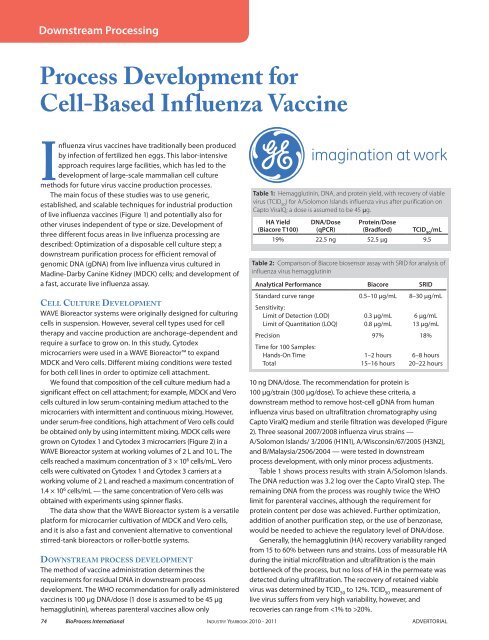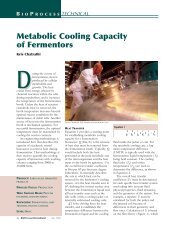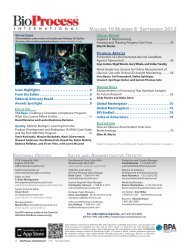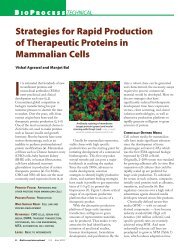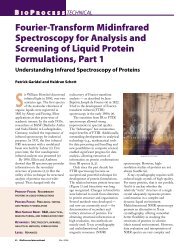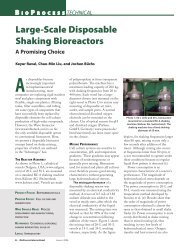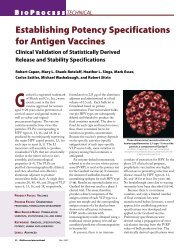Process Development for Cell-Based Influenza Vaccine
Process Development for Cell-Based Influenza Vaccine
Process Development for Cell-Based Influenza Vaccine
You also want an ePaper? Increase the reach of your titles
YUMPU automatically turns print PDFs into web optimized ePapers that Google loves.
Downstream <strong>Process</strong>ing<br />
<strong>Process</strong> <strong>Development</strong> <strong>for</strong><br />
<strong>Cell</strong>-<strong>Based</strong> <strong>Influenza</strong> <strong>Vaccine</strong><br />
<strong>Influenza</strong> virus vaccines have traditionally been produced<br />
by infection of fertilized hen eggs. this labor-intensive<br />
approach requires large facilities, which has led to the<br />
development of large-scale mammalian cell culture<br />
methods <strong>for</strong> future virus vaccine production processes.<br />
the main focus of these studies was to use generic,<br />
established, and scalable techniques <strong>for</strong> industrial production<br />
of live influenza vaccines (Figure 1) and potentially also <strong>for</strong><br />
other viruses independent of type or size. development of<br />
three different focus areas in live influenza processing are<br />
described: optimization of a disposable cell culture step; a<br />
downstream purification process <strong>for</strong> efficient removal of<br />
genomic dNa (gdNa) from live influenza virus cultured in<br />
Madine-darby Canine Kidney (MdCK) cells; and development of<br />
a fast, accurate live influenza assay.<br />
Ce l l Cu lt u r e De v e l o p m e n t<br />
Wave Bioreactor systems were originally designed <strong>for</strong> culturing<br />
cells in suspension. However, several cell types used <strong>for</strong> cell<br />
therapy and vaccine production are anchorage-dependent and<br />
require a surface to grow on. in this study, Cytodex<br />
microcarriers were used in a Wave Bioreactor to expand<br />
MdCK and vero cells. different mixing conditions were tested<br />
<strong>for</strong> both cell lines in order to optimize cell attachment.<br />
We found that composition of the cell culture medium had a<br />
significant effect on cell attachment; <strong>for</strong> example, MdCK and vero<br />
cells cultured in low serum-containing medium attached to the<br />
microcarriers with intermittent and continuous mixing. However,<br />
under serum-free conditions, high attachment of vero cells could<br />
be obtained only by using intermittent mixing. MdCK cells were<br />
grown on Cytodex 1 and Cytodex 3 microcarriers (Figure 2) in a<br />
Wave Bioreactor system at working volumes of 2 l and 10 l. the<br />
cells reached a maximum concentration of 3 × 10 6 cells/ml. vero<br />
cells were cultivated on Cytodex 1 and Cytodex 3 carriers at a<br />
working volume of 2 l and reached a maximum concentration of<br />
1.4 × 10 6 cells/ml — the same concentration of vero cells was<br />
obtained with experiments using spinner flasks.<br />
the data show that the Wave Bioreactor system is a versatile<br />
plat<strong>for</strong>m <strong>for</strong> microcarrier cultivation of MdCK and vero cells,<br />
and it is also a fast and convenient alternative to conventional<br />
stirred-tank bioreactors or roller-bottle systems.<br />
Do w n s t r e a m p r o C e s s D e v e l o p m e n t<br />
the method of vaccine administration determines the<br />
requirements <strong>for</strong> residual dNa in downstream process<br />
development. the WHo recommendation <strong>for</strong> orally administered<br />
vaccines is 100 µg dNa/dose (1 dose is assumed to be 45 µg<br />
hemagglutinin), whereas parenteral vaccines allow only<br />
Table 1: Hemagglutinin, DNA, and protein yield, with recovery of viable<br />
virus (TCID 50 ) <strong>for</strong> A/Solomon Islands influenza virus after purification on<br />
Capto ViralQ; a dose is assumed to be 45 µg.<br />
HA Yield<br />
(Biacore T100)<br />
DNA/Dose<br />
(qPCR)<br />
Protein/Dose<br />
(Brad<strong>for</strong>d) TCID 50 /mL<br />
19% 22.5 ng 52.5 µg 9.5<br />
Table 2: Comparison of Biacore biosensor assay with SRID <strong>for</strong> analysis of<br />
influenza virus hemagglutinin<br />
Analytical Per<strong>for</strong>mance Biacore SRID<br />
Standard curve range 0.5–10 µg/ml 8–30 µg/ml<br />
Sensitivity:<br />
limit of detection (lod)<br />
limit of Quantitation (loQ)<br />
0.3 µg/ml<br />
0.8 µg/ml<br />
6 µg/ml<br />
13 µg/ml<br />
Precision 97% 18%<br />
time <strong>for</strong> 100 Samples:<br />
Hands-on time<br />
total<br />
1–2 hours<br />
15–16 hours<br />
6–8 hours<br />
20–22 hours<br />
10 ng dNa/dose. the recommendation <strong>for</strong> protein is<br />
100 µg/strain (300 µg/dose). to achieve these criteria, a<br />
downstream method to remove host-cell gdNa from human<br />
influenza virus based on ultrafiltration chromatography using<br />
Capto viralQ medium and sterile filtration was developed (Figure<br />
2). three seasonal 2007/2008 influenza virus strains —<br />
a/Solomon islands/ 3/2006 (H1N1), a/Wisconsin/67/2005 (H3N2),<br />
and B/Malaysia/2506/2004 — were tested in downstream<br />
process development, with only minor process adjustments.<br />
table 1 shows process results with strain a/Solomon islands.<br />
the dNa reduction was 3.2 log over the Capto viralQ step. the<br />
remaining dNa from the process was roughly twice the WHo<br />
limit <strong>for</strong> parenteral vaccines, although the requirement <strong>for</strong><br />
protein content per dose was achieved. Further optimization,<br />
addition of another purification step, or the use of benzonase,<br />
would be needed to achieve the regulatory level of dNa/dose.<br />
Generally, the hemagglutinin (Ha) recovery variability ranged<br />
from 15 to 60% between runs and strains. loss of measurable Ha<br />
during the initial microfiltration and ultrafiltration is the main<br />
bottleneck of the process, but no loss of Ha in the permeate was<br />
detected during ultrafiltration. the recovery of retained viable<br />
virus was determined by tCid 50 to 12%. tCid 50 measurement of<br />
live virus suffers from very high variability, however, and<br />
recoveries can range from 20%.<br />
74 Bio<strong>Process</strong> International In d u s t r y ye a r b o o k 2010 - 2011 advertorial
Figure 1: Overview of a cell-based influenza vaccine process showing<br />
reduction of total DNA content (purple)<br />
HiPrep 26/10<br />
<strong>Cell</strong> culture<br />
MDCK cells on Cytodex 3 carriers<br />
116.4 × 10 6 ng DNA<br />
Clari�cation<br />
ULTA Prime GF 2 µm -<br />
ULTA Prime GF 0.6 µm<br />
39.3 × 10 6 ng DNA<br />
Ultra�ltration/Dia�ltration<br />
Cross�ow �ltration, UFP-500-C<br />
9.50 × 10 6 ng DNA<br />
Nonbinding Anion-Exchange<br />
Chromatography<br />
Capto ViralQ �ltration<br />
5.06 × 10 3 ng DNA<br />
Ultra�ltration/Dia�ltration<br />
Cross�ow �ltration, UFP-500-C<br />
3.99 × 10 3 ng DNA<br />
Sterile �ltration<br />
ULTA Pure SF 0.2 µm<br />
2.06 × 10 3 ng DNA<br />
In f l u e n z a an a ly s I s De v e l o p m e n t<br />
the potency of influenza vaccines are mainly determined by<br />
quantitation of Ha using the single radial immunodiffusion (Srid)<br />
assay. this method, although approved by both Fda and eMea, is<br />
labor-intensive and suffers from low precision and sensitivity.<br />
Biacore biosensor assays offer an alternative to Srid <strong>for</strong><br />
vaccine development and manufacturing. Quantitation of<br />
influenza Ha using Biacore biosensor assay is per<strong>for</strong>med in an<br />
indirect manner as an inhibition assay (Figure 3). Biacore<br />
biosensor quantitation of influenza Ha using Biacore t100 system<br />
shows significantly higher sensitivity and precision compared<br />
with Srid (table 2). in addition, the analysis time is shorter.<br />
Co n C l u s I o n s<br />
optimal microcarrier conditions in Wave Bioreactor were<br />
developed demonstrating the potential <strong>for</strong> fully disposable<br />
influenza vaccine manufacturing from adherent MdCK cells. a<br />
generic and efficient purification process was developed <strong>for</strong> the<br />
removal of gdNa and host cell–derived impurities from MdCK<br />
cell-based influenza. a further purification step is, however,<br />
required to achieve vaccine purity according to WHo<br />
recommendations. a Biacore based influenza analysis was<br />
developed and shown to be more accurate and faster than Srid.<br />
advertorial In d u s t r y ye a r b o o k 2010 - 2011<br />
Figure 2: Morphology of Vero cells on Cytodex 1 (top) and Cytodex 3<br />
(bot tom) microcarriers after four days’ growth in a WAVE bioreactor system<br />
Cytodex 1<br />
Cytodex 3<br />
Figure 3: Principle of inhibition in Biacore T100 system; HA is first<br />
immobilized on a dextran matrix (red-filled circles); virus is then mixed with a<br />
fixed concentration of serum and injected over the surface. Free antibodies<br />
(not bound to virus at equilibrium) bind to the surface HA, giving a response.<br />
Low concentration of virus in the sample a) gives high antibody binding,<br />
whereas high virus concentration b) results in low binding level.<br />
A) B)<br />
Björn Lundgren is the vaccine marketing manager at GE Healthcare<br />
Bio-Sciences AB, Björkgatan 30, 75184 Uppsala, Sweden, bjorn.<br />
lundgren@ge.com; www.gelifesciences.com/bioprocess.<br />
Bio<strong>Process</strong> International 75


